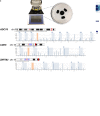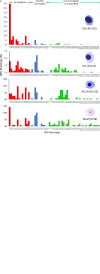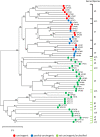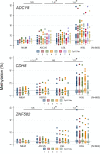Molecular Pap Smear: Validation of HPV Genotype and Host Methylation Profiles of ADCY8, CDH8, and ZNF582 as a Predictor of Cervical Cytopathology
- PMID: 33178175
- PMCID: PMC7593258
- DOI: 10.3389/fmicb.2020.595902
Molecular Pap Smear: Validation of HPV Genotype and Host Methylation Profiles of ADCY8, CDH8, and ZNF582 as a Predictor of Cervical Cytopathology
Abstract
Primary high-risk Human Papillomavirus (hrHPV) screening has recently become an accepted standalone or co-test with conventional cytology. Unfortunately, hrHPV singularly lacks specificity for cytopathological grade. However, mechanisms and markers of evolving virus-host interactions at the epigenome level may be harnessed as a better predictor of carcinogenesis. This study aimed to validate and expand the clinical performance of a multiparametric biomarker panel, referred to as the "Molecular Pap smear" based, on HPV genotype and ADCY8, CDH8 and ZNF582 CpG-methylation as a predictive classifier of cervical cytology. This prospective, cross-sectional study used an independent cohort of residual liquid-based cytology for HPV genotyping and epigenetic analysis. Extracted DNA underwent parallel PCR using 3 primer sets for HPV DNA amplification. HPV-infected samples were genotyped by Sanger sequencing. Promoter methylation levels of 3 tumor suppressor genes were quantified by bisulfite-pyrosequencing of genomic DNA on the newest high-resolution PyroMark Q48 platform. Logistic model performance was compared, and model parameters were used to predict and classify binary cytological outcomes. A total of 883 samples were analyzed. HPV DNA positivity correlated with worsening grade: 125/237 (53%) NILM; 136/235 (58%) ASCUS; 222/229 (97%) LSIL; and 157/182 (86%) HSIL samples. The proportion of carcinogenic HPV-types in PCR-positive sequenceable samples correlated with worsening grade: NILM 34/98 (35%); ASCUS 50/113 (44%); LSIL 92/214 (43%); HSIL 129/152 (85%). Additionally, ADCY8, CDH8, and ZNF582 methylation levels increased in direct correlation with worsening grade. Overall, the multi-marker modeling parameters predicted binarized cytological outcomes better than HPV-type alone with significantly higher area under the receiver operator curve (AUC)s, respectively: NILM vs. > NILM (AUC 0.728 vs. 0.709); NILM/ASCUS vs. LSIL/HSIL (AUC 0.805 vs. 0.776); and <HSIL vs. HSIL (AUC 0.830 vs. 0.761). Our expanded findings validated the multivariable prediction model developed for cytological classification. The sequencing-based "Molecular Pap smear" outperformed HPV-type alone in predicting four grades of cervical cytology. Additional host epigenetic markers that evolved with disease progression decidedly contributed to the overall classification accuracy.
Keywords: DNA methylation; carcinogenesis; epigenetic modification; evolution; host-pathogen interactions; human papillomavirus infection; pap smear; pyrosequencing.
Copyright © 2020 Shen-Gunther, Xia, Stacey and Asusta.
Figures






Similar articles
-
Molecular Pap smear: HPV genotype and DNA methylation of ADCY8, CDH8, and ZNF582 as an integrated biomarker for high-grade cervical cytology.Clin Epigenetics. 2016 Sep 13;8(1):96. doi: 10.1186/s13148-016-0263-9. eCollection 2016. Clin Epigenetics. 2016. PMID: 27651839 Free PMC article.
-
Role of genomic DNA methylation in detection of cytologic and histologic abnormalities in high risk HPV-infected women.PLoS One. 2019 Jan 4;14(1):e0210289. doi: 10.1371/journal.pone.0210289. eCollection 2019. PLoS One. 2019. PMID: 30608989 Free PMC article.
-
Quantitative methylation-specific PCR for the detection of aberrant DNA methylation in liquid-based Pap tests.Cancer. 2008 Feb 25;114(1):57-64. doi: 10.1002/cncr.23258. Cancer. 2008. PMID: 18181097 Free PMC article.
-
Evidence regarding human papillomavirus testing in secondary prevention of cervical cancer.Vaccine. 2012 Nov 20;30 Suppl 5:F88-99. doi: 10.1016/j.vaccine.2012.06.095. Vaccine. 2012. PMID: 23199969 Review.
-
The use of human papillomavirus DNA methylation in cervical intraepithelial neoplasia: A systematic review and meta-analysis.EBioMedicine. 2019 Dec;50:246-259. doi: 10.1016/j.ebiom.2019.10.053. Epub 2019 Nov 12. EBioMedicine. 2019. PMID: 31732479 Free PMC article.
Cited by
-
A Customized Human Mitochondrial DNA Database (hMITO DB v1.0) for Rapid Sequence Analysis, Haplotyping and Geo-Mapping.Int J Mol Sci. 2023 Aug 31;24(17):13505. doi: 10.3390/ijms241713505. Int J Mol Sci. 2023. PMID: 37686313 Free PMC article.
-
Strain-Specific Identification and In Vivo Immunomodulatory Activity of Heat-Killed Latilactobacillus sakei K040706.Foods. 2021 Dec 7;10(12):3034. doi: 10.3390/foods10123034. Foods. 2021. PMID: 34945585 Free PMC article.
-
HPV Infection and Oral Microbiota: Interactions and Future Implications.Int J Mol Sci. 2025 Feb 8;26(4):1424. doi: 10.3390/ijms26041424. Int J Mol Sci. 2025. PMID: 40003891 Free PMC article. Review.
-
HPV DeepSeq: An Ultra-Fast Method of NGS Data Analysis and Visualization Using Automated Workflows and a Customized Papillomavirus Database in CLC Genomics Workbench.Pathogens. 2021 Aug 13;10(8):1026. doi: 10.3390/pathogens10081026. Pathogens. 2021. PMID: 34451490 Free PMC article.
-
Prevalence of high and low risk HPV genotypes among vaccinated and non-vaccinated people in Tehran.Virol J. 2024 Jan 5;21(1):9. doi: 10.1186/s12985-023-02270-1. Virol J. 2024. PMID: 38183101 Free PMC article.
References
-
- Bosch F. X., Broker T. R., Forman D., Moscicki A. B., Gillison M. L., Doorbar J. (2013). ‘Comprehensive Control of HPV Infections and Related Diseases’ Vaccine Volume 30, Supplement 5, 2012. Comprehensive control of human papillomavirus infections and related diseases. Vaccine 31(Suppl. 8), I1–I31. 10.1016/j.vaccine.2013.07.026 - DOI - PMC - PubMed
LinkOut - more resources
Full Text Sources
Research Materials

